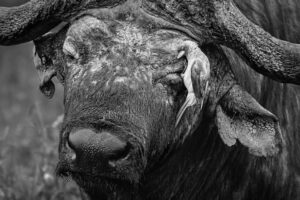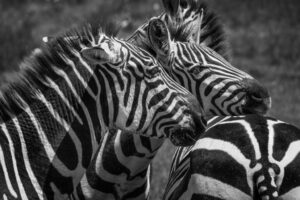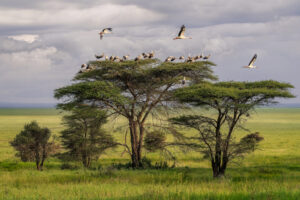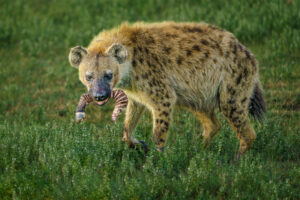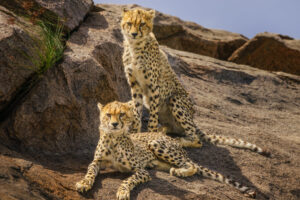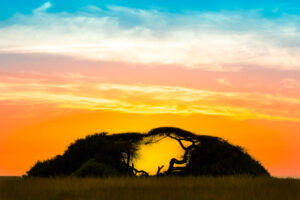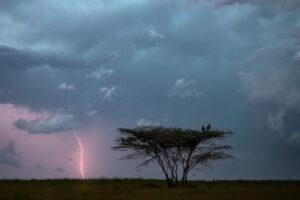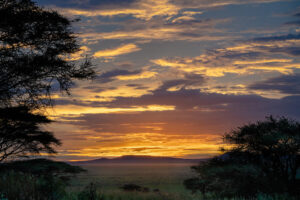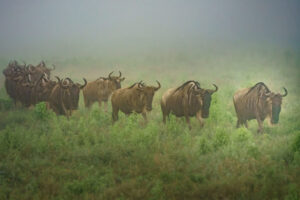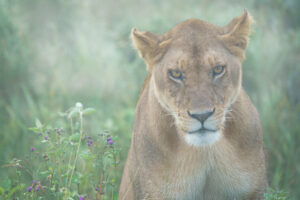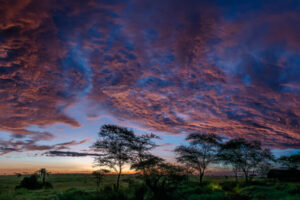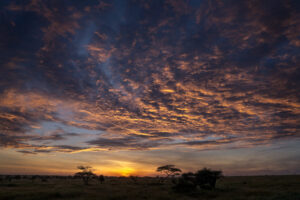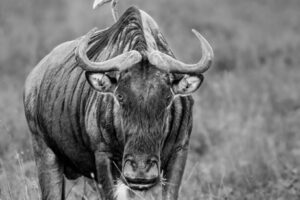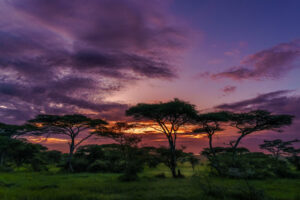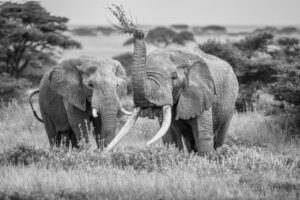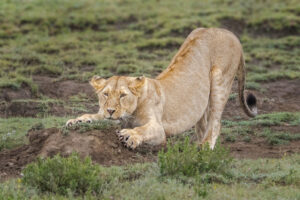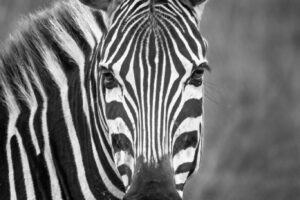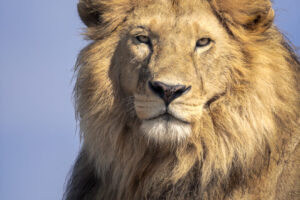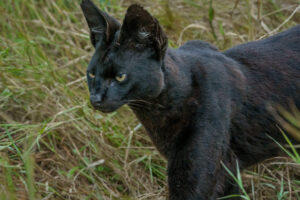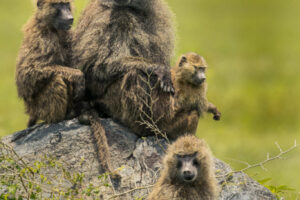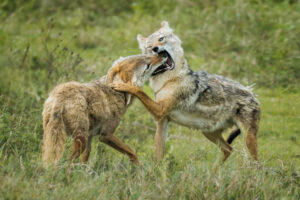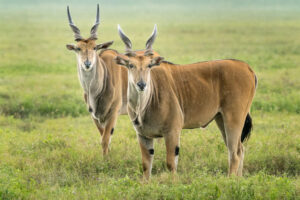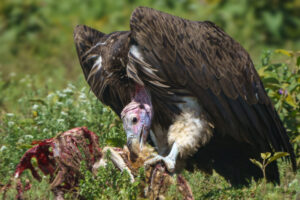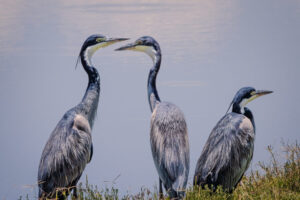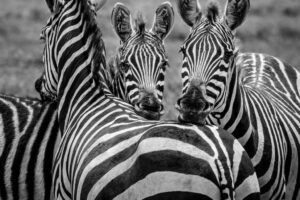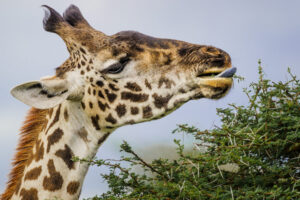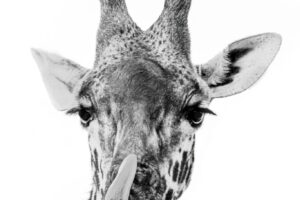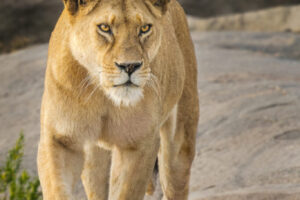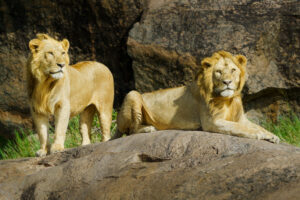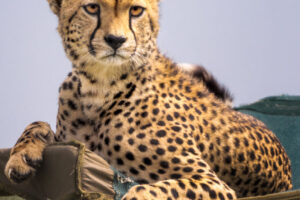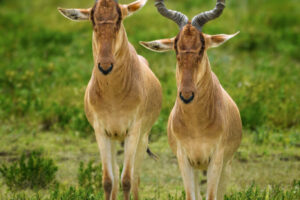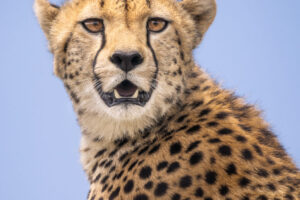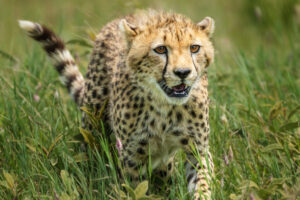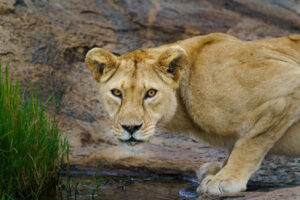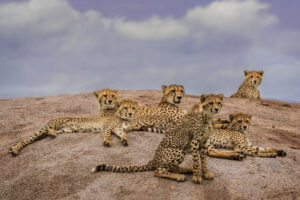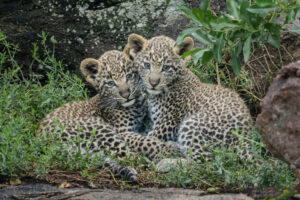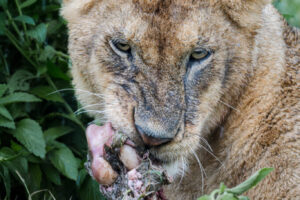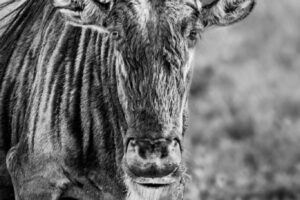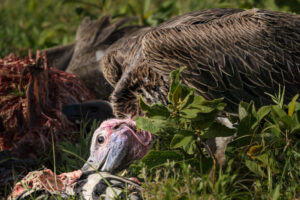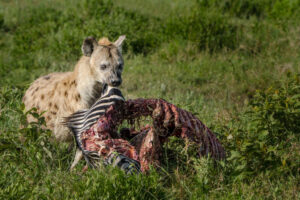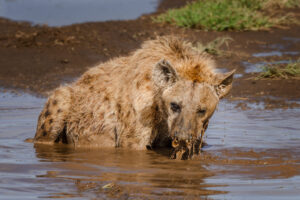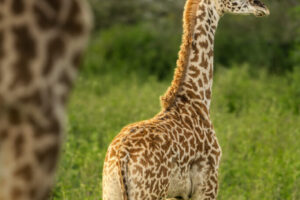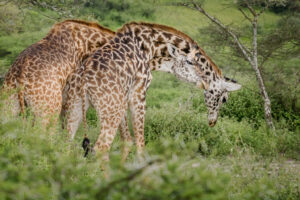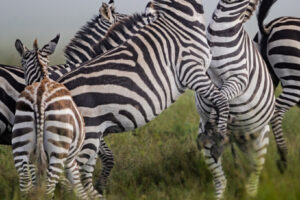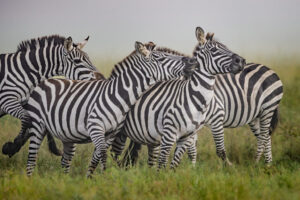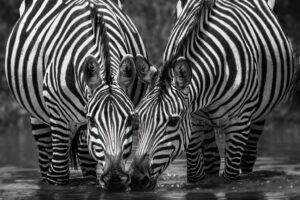With more than two million large mammals, Tanzania is home to the Ngorongoro Crater and the Serengeti. This immense African wilderness allows vast migratory herds to circulate as they have for thousands of years.
A UNESCO World Heritage Site, the Ngorongoro Crater is a large volcanic caldera that is a unique ecosystem unto itself. Teeming with wildlife, the crater floor is 2,000 feet deep and covers 100 square miles. Mostly open grassland with two prominent wooded areas, the crater floor provides a habitat for between 25,000 and 30,000 animals, including lions, black rhino, wildebeest, cape buffalo, zebra, hyena, elephant, gazelles, monkeys, and many more.
Serengeti means “endless plains” in Kiswahili. This 6,900 square mile area is the site of the largest mammal migration in the world. The Great Migration is the ever-moving circular migration of over a million animals across the Serengeti-Mara ecosystem. The constant movement of columns of wildebeest and zebra follow an ancient route in search of grazing and water.
After calving in February in the southern part of Tanzania’s Serengeti near the Ngorongoro Conservation Area, the animals journey north through the Serengeti up and around in a clockwise direction. In August, the animals attempt to cross the crocodile-infested Mara River to get to the Masai Mara in Kenya. In October, the animals face the swollen waters of the Mara River for the second time as they cross on their return journey south. When the rains begin in November, the animals are propelled to the now fertile southern Serengeti. By the beginning of December, Ndutu starts seeing the herds return to calve, and the whole process begins anew.
In addition to the Serengeti and Ngorongoro Crater, Tanzania boasts the Tarangire, Ruaha and Mahale Mountain National Parks, as well as the Selous Game Reserve and Mount Kilimanjaro, all of which offer their own thrilling natural adventures. As such, the following photo essay only begins to shed some light on the wonders of Tanzania.
- Looking At You Ngorongoro Crater, Tanzania | Mar 2020
- Cleaning Up Ngorongoro Crater, Tanzania | Mar 2020
- Zebra Ngorongoro Crater, Tanzania | Mar 2020
- Resting Zebra I Ngorongoro Crater, Tanzania | Mar 2020
- Black Storks Serengeti, Tanzania | Mar 2020
- Hyena Savenging Gul Kopjes, Serengeti, Tanzania | Mar 2020
- Tail End Cheetah, Gul Kopjes, Tanzania | Mar 2020
- Cheetah Siblings Gul Kopjes, Serengeti, Tanzania | Mar 2020
- Sunset I Gul Kopjes, Serengeti, Tanzania | Mar 2020
- Vultures Watching Lightning Gul Kopjes, Serengeti, Tanzania | Mar 2020
- Sunset II Gul Kopjes, Serengeti, Tanzania | Mar 2020
- The Migration Continues Gul Kopjes, Serengeti, Tanzania | Mar 2020
- Unheppy Lion in Fog Simbra Kopjes, Serengeti, Tanzania | Mar 2020
- Making Waves Seronera, Serengeti, Tanzania | Mar 2020
- Elephant "Handshake" Gul Kopjes, Serengeti, Tanzania | Mar 2020
- Lilac Breasted Roller Gul Kopjes, Serengeti, Tanzania | Mar 2020
- Serengeti Sunset I Serengeti, Tanzania | Mar 2020
- Serengeti Sunset II Serengeti, Tanzania | Mar 2020
- A Shy Dik Dik Seronera, Serengeti, Tanzania | Mar 2020
- Riding Along Egret & Wildebeest, Simba Kopjes, Serengeti, Tanzania | Mar 2020
- Sunset II Gul Kopjes, Serengeti, Tanzania | Mar 2020
- Fresh Kill II Gul Kopjes, Serengeti, Tanzania | Mar 2020
- Elephant Gul Kopjes, Serengeti, Tanzania | Mar 2020
- Stretch Barufu, Serengeti, Tanzania | Mar 2020
- Fresh Kill III Barufu, Serengeti, Tanzania | Mar 2020
- Zebra Portrait Barufu, Serengeti, Tanzania | Mar 2020
- King of the Beasts Caracol, Serengeti, Tanzania | Mar 2020
- Serval Stalking Serengeti, Tanzania | Mar 2020
- Lurking Ngorongoro Crater, Tanzania | Mar 2020
- Who's Ugly? Ngorongoro Crater, Tanzania | Mar 2020
- Zebra Dining I Ngorongoro Crater, Tanzania | Mar 2020
- Baboon Family Ngorongoro Crater, Tanzania | Mar 2020
- Golden Jackals Fighting Ngorongoro Crater, Tanzania | Mar 2020
- Elands in the Rain Ngorongoro Crater, Tanzania | Mar 2020
- Carrion Dinner I White Backed Vulture, Serengeti, Tanzania | Mar 2020
- Look Both Ways Serengeti, Tanzania | Mar 2020
- Odd Man Out Black Headed Heron, Serengeti, Tanzania | Mar 2000
- Resting Zebra II Serengeti, Tanzania | Mar 2020
- Thorny Deliciousness Serengeti, Tanzania | Mar 2020
- Yum! Serengeti, Tanzania | Mar 2020
- Zebra Dining II Gul Kopjes, Serengeti, Tanzania | Mar 2020
- Apex Predator Gul Kopjes, Serengeti, Tanzania | Mar 2020
- Fresh Kill I Gul Kopjes, Serengeti, Tanzania | Mar 2020
- Kings of the Serengeti Gul Kopjes, Serengeti, Tanzania | Mar 2020
- Resting Cheetah Gul Kopjes, Serengeti, Tanzania | Mar 2020
- Hartebeest Gul Kopjes, Serengeti, Tanzania | Mar 2020
- Cheetah Gul Kopjes, Serengeti, Tanzania | Mar 2020
- Cheetah Cub Gul Kopjes, Serengeti, Tanzania | Mar 2020
- Time for a Drink Gul Kopjes, Serengeti, Tanzania | Mar 2020
- Zebra Pair | Gul Kopjes, Serengeti, Tanzania | Mar 2020
- Cheetah Family Gul Kopjes, Serengeti, Tanzania | Mar 2020
- Leopard Cub Gul Kopjes, Serengeti, Tanzania | Mar 2020
- Leopard Siblings Gul Kopjes, Serengeti, Tanzania | Mar 2020
- Dinner Gul Kopjes, Serengeti, Tanzania | Mar 2020
- Wildebeest Gul Kopjes, Serengeti, Tanzania | Mar 2020
- Roar Gul Kopjes, Serengeti, Tanzania | Mar 2020
- Carrion Dinner II Gul Kopjes, Serengeti, Tanzania | Mar 2020
- Hyena's Dinner Gul Kopjes, Serengeti, Tanzania | Mar 2020
- Washing Up Hyena, Gul Kopjes, Serengeti, Tanzania | Mar 2020
- Giraffe Close-Up Ndutu, Serengeti, Tanzania | Mar 2020
- Keeping Watch Ndutu, Serengeti, Tanzania | Mar 2020
- Giraffe Fighting Ndutu, Serengeti, Tanzania | Mar 2020
- Zebra Fight I Simbra Kopjes, Serengeti, Tanzania | Mar 2020
- Zebra Fight II Simbra Kopjes, Serengeti, Tanzania | Mar 2020
- Stopping For A Drink Gul Kopjes, Serengeti, Tanzania | Mar 2020


